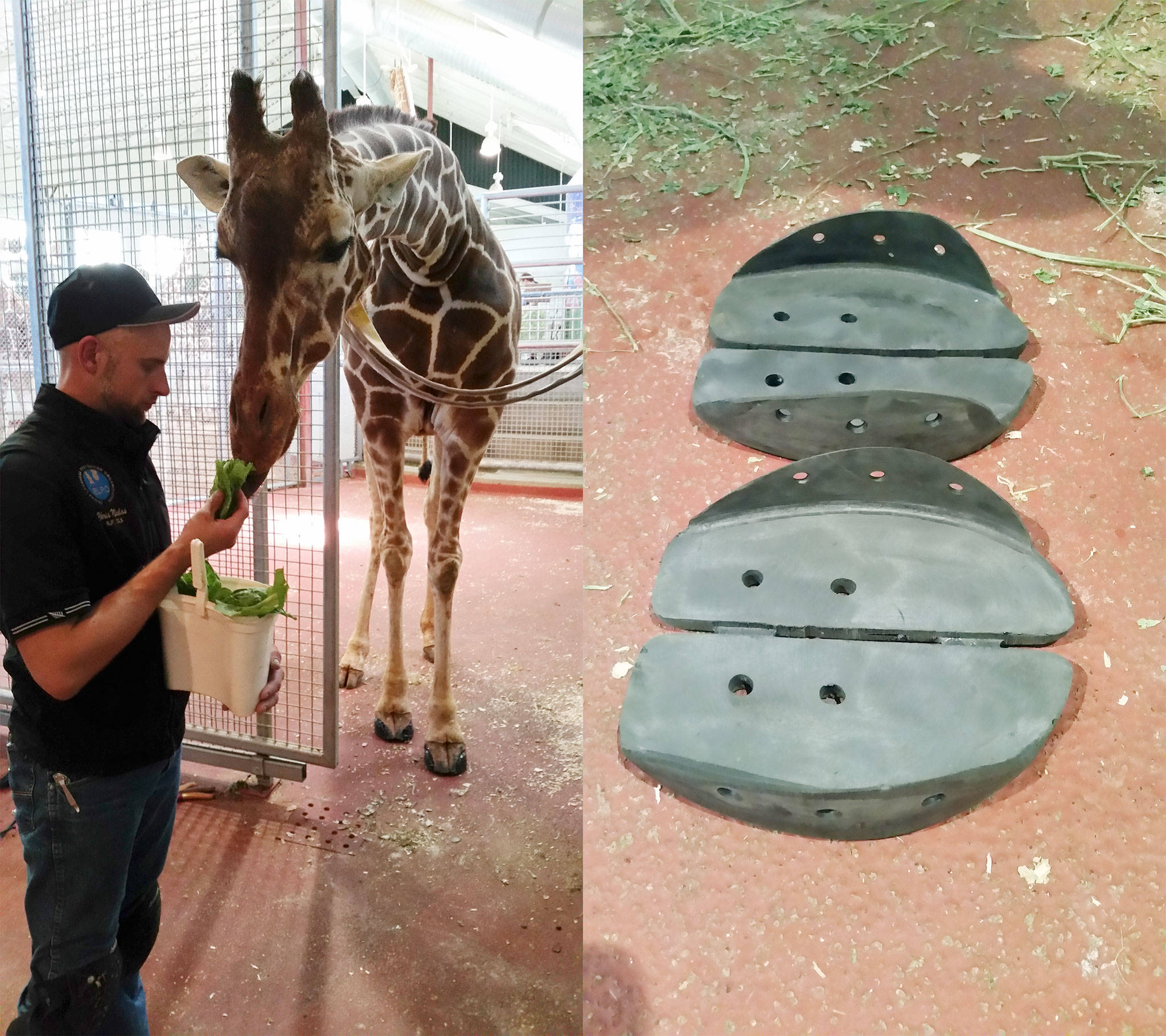Sequim farrier Chris Niclas had the opportunity to apply his career and passion to a most unusual client: a giraffe named Twiga.
Niclas, a New Zealand native and Sequim resident with 25 years of learning and mastering the skills to become a professional farrier, flew to Cheyenne Mountain Zoo in Colorado Springs, Colo., to provide customized rubber shoes he built for Twiga’s feet — a 16-year-old giraffe born in human care that suffers from arthritis and osteoporosis.
He and a team of zoo staff attempted to fit and glue the shoes on Thursday, May 4, and the result was a success — or as Niclas refers to it, “a small miracle.”
“It’s never been done before what we did,” Niclas said of the experiment.
Niclas built the shoes for Twiga and Steve Foxworth, master farrier at the zoo and President of the Equine Lameness and Prevention Organization (ELPO) trimmed Twiga’s hooves and glued on the shoes. To Niclas’ knowledge, gluing on rubber shoes has been done before to horses and cows but has never been done to exotic animals, such as a giraffe.
Niclas has been studying and practicing this technique of using a rubber shoe and an adhesive glue instead of a metal horseshoe and nails at his personal farrier business in Sequim since 2007. With influences from other farriers such as Garrett Ford, Mark Plumlee and Gene Ovenick, he has learned to incorporate these skills into his own practice.
“This is new in multiple ways,” Cheyenne Mountain Zoo head veterinarian and vice president of mission and programs Dr. Liza Dadone said. “This is the first time a giraffe let shoes be applied to it awake.”
Dadone said in the past zoos did not have the skills to train animals to voluntarily participate in these procedures. Usually zoo staff, like herself, would use a dart gun or an anesthetic in order to sedate the animal to maintain its healthcare.
“Immediately the giraffe shifted her weight to test out the shoe,” Dadone said. “She came back over and put her foot on the block to put the second one on.”
Dadone added at the Cheyenne Mountain Zoo in particular, zoo staff have been training the animals as active participants in their healthcare, such as training the giraffe to put their feet on blocks for hoof trimmings and maintenance.
“It’s an exciting way the animals can be part of the process,” Dadone said.
Niclas said the shoes he made for Twiga — or as Dadone calls them “sneakers” — are a rubber material with a cuff that comes up around the edge of the foot and glues to the side of the wall and the bottom of the foot.
“The boot is helping to ease the pressure on her joints and to stabilize her,” Public Relations and Social Media Manager Andrea Bolt said. “It’s just one of many advanced veterinary treatments we employ to ensure our animals are living the healthiest, happiest lives possible.”
Niclas and Foxworth also worked with zoo animal manager for giraffe Amy Schilz in order to glue the boots on Twiga’s front feet.
Niclas is unsure of how long the shoes will last but Dadone said she is estimating they will stay on for six weeks. Zoo staff will then evaluate Twiga’s feet after wearing the shoes to determine the next steps for managing her condition.
Bolt said the zoo hopes to monitor Twiga’s reaction and progress so that others may use this technique to help veterinary teams at other zoos and aquariums to benefit their animals as well.
Dadone added the zoo is a conservation organization and is known for having one of the largest herds of giraffe in North America with 17 giraffe in its facility. She stated that giraffe are at an incresaed risk of extinction with populations decreasing over the years by 40 percent.
“We’re very open and want to help everyone provide the best care for their animals,” Dadone said.
Niclas said his farrier business is a passion as well as a career. He said all the work he did for Twiga was done on a volunteer basis.
“She was happy standing on it,” Niclas said when he finally put one rubber shoes on Twiga’s foot. ”She noticed the difference and was more than happy to let us work on the other foot.”
In a previous attempt to put on a prototype of shoes he made for Twiga’s feet back in April, it was unsuccessful because the shoes were too small and Twiga did not want to participate.
He said his curiosity and passion for his work as a farrier is what led him to participate in this experimental process along with knowing Foxworth who recruited him to make the shoes for Twiga.
“At this point in my life, if I had to put a percentage on things, I know about 10 percent and another 90 percent I learn,” Niclas said. He added this was a learning opportunity and did not want the fear of failure to hold him back from growing in his profession.
Others that influenced the work involved in this project include Daisy Bicking, Matthew Staples and the ELPO.



